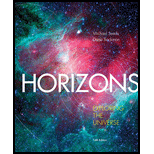
Horizons: Exploring the Universe (MindTap Course List)
14th Edition
ISBN: 9781305960961
Author: Michael A. Seeds, Dana Backman
Publisher: Cengage Learning
expand_more
expand_more
format_list_bulleted
Textbook Question
Chapter 19, Problem 3P
If a trillion (1012) asteroids, each 1 km in diameter, were assembled into one body, how Large would it be? (Hint: The volume of a sphere
Expert Solution & Answer
Trending nowThis is a popular solution!

Students have asked these similar questions
If a trillion (1012) asteroids, each 9 km in diameter, were assembled into one spherical body, how large (in km) would it be? (Note: The volume of a sphere
=
4
3
?r3.)
km
Compare that body's size to the size of Earth given in its celestial profile.
d
dEarth
=
Chapter 19 Solutions
Horizons: Exploring the Universe (MindTap Course List)
Ch. 19 - What do Widmanst?tten patterns indicate about the...Ch. 19 - What do chondrules tell you about the history of...Ch. 19 - Why are there no chondrules in achondritic...Ch. 19 - Why do astronomers refer to carbonaceous...Ch. 19 - Prob. 5RQCh. 19 - Prob. 6RQCh. 19 - Why do astronomers think the asteroids were never...Ch. 19 - Prob. 8RQCh. 19 - What evidence indicates that some asteroids have...Ch. 19 - What evidence indicates that some asteroids have...
Ch. 19 - Prob. 11RQCh. 19 - What is the difference between a gas tail and a...Ch. 19 - Prob. 13RQCh. 19 - What are the hypotheses for how the bodies in the...Ch. 19 - Prob. 15RQCh. 19 - Prob. 1DQCh. 19 - Do you think the government should spend money to...Ch. 19 - Prob. 1PCh. 19 - If a single asteroid 1 km in diameter were to be...Ch. 19 - If a trillion (1012) asteroids, each 1 km in...Ch. 19 - Prob. 4PCh. 19 - What is the maximum angular diameter of the...Ch. 19 - Prob. 6PCh. 19 - Prob. 7PCh. 19 - Prob. 8PCh. 19 - What is the orbital period of a comet nucleus in...Ch. 19 - The mass of an average comet’s nucleus is about...Ch. 19 - Prob. 1LTLCh. 19 - Prob. 2LTLCh. 19 - Prob. 3LTL
Knowledge Booster
Learn more about
Need a deep-dive on the concept behind this application? Look no further. Learn more about this topic, physics and related others by exploring similar questions and additional content below.Similar questions
- In addition to the ones mentioned in Exercise 13.3, what is the third, rarer class of asteroids?arrow_forwardIf a trillion (1012) asteroids, each 1 km in diameter, were assembled into one spherical body, how large would that the spherical body be? Compare that bodys size to the size of Earth given in its Celestial Profile. (Note: The volume of a sphere = 43r3.)arrow_forwardWhy is it more useful to classify meteorites according to whether they are primitive or differentiated rather than whether they are stones, irons, or stony-irons?arrow_forward
- How would studying the chemical composition of only the largest, brightest, and most easily observed asteroids yield potentially misleading information about asteroids in general? Why is this called a selection effect?arrow_forwardThe mass of the asteroids is found mostly in the larger asteroids, so to estimate the total mass we need to consider only the larger objects. Suppose the three largest asteroids-Ceres (1000 km in diameter), Pallas (500 km in diameter), and Vesta (500 km in diameter)-account for half the total mass. Assume that each of these three asteroids has a density of 3 g/cm3 and calculate their total mass. Multiply your result by 2 to obtain an estimate for the mass of the total asteroid belt. How does this compare with the mass of the Oort cloud?arrow_forwardWhat do Widmansttten patterns indicate about the history of iron meteorites?arrow_forward
- Give at least two reasons today’s astronomers are so interested in the discovery of additional Earthapproaching asteroids.arrow_forwardWhat is the orbital period of a comet nucleus at the inner edge of the Oort Cloud? What is its orbital velocity? Assume a circular orbit. (Hint: Use Keplers third law, Eq. 4-1) (Note: The circumference of a circle is 2r.)arrow_forwardVesta is unusual as it contains what mineral on its surface? What does the presence of this material indicate?arrow_forward
arrow_back_ios
arrow_forward_ios
Recommended textbooks for you
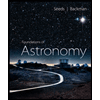 Foundations of Astronomy (MindTap Course List)PhysicsISBN:9781337399920Author:Michael A. Seeds, Dana BackmanPublisher:Cengage Learning
Foundations of Astronomy (MindTap Course List)PhysicsISBN:9781337399920Author:Michael A. Seeds, Dana BackmanPublisher:Cengage Learning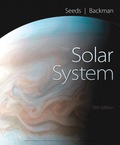
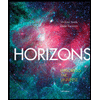 Horizons: Exploring the Universe (MindTap Course ...PhysicsISBN:9781305960961Author:Michael A. Seeds, Dana BackmanPublisher:Cengage Learning
Horizons: Exploring the Universe (MindTap Course ...PhysicsISBN:9781305960961Author:Michael A. Seeds, Dana BackmanPublisher:Cengage Learning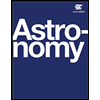 AstronomyPhysicsISBN:9781938168284Author:Andrew Fraknoi; David Morrison; Sidney C. WolffPublisher:OpenStax
AstronomyPhysicsISBN:9781938168284Author:Andrew Fraknoi; David Morrison; Sidney C. WolffPublisher:OpenStax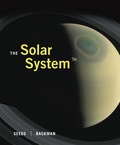

Foundations of Astronomy (MindTap Course List)
Physics
ISBN:9781337399920
Author:Michael A. Seeds, Dana Backman
Publisher:Cengage Learning


Horizons: Exploring the Universe (MindTap Course ...
Physics
ISBN:9781305960961
Author:Michael A. Seeds, Dana Backman
Publisher:Cengage Learning

Astronomy
Physics
ISBN:9781938168284
Author:Andrew Fraknoi; David Morrison; Sidney C. Wolff
Publisher:OpenStax

Kepler's Three Laws Explained; Author: PhysicsHigh;https://www.youtube.com/watch?v=kyR6EO_RMKE;License: Standard YouTube License, CC-BY